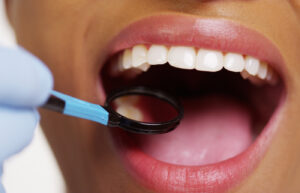
Many times we think of a clean mouth as a sterile mouth, but we need a proper balance of bacteria in our oral microbiome in order to be healthy and to produce nitric oxide.
Nitric oxide is most known for its role in heart health for being a potent vasodilator (keeps your arteries and veins from narrowing or contracting shut) and regulator of blood pressure. But it also:
- reduces inflammation,
- impacts memory and behavior (via nerve cells in the brain),
- improves sleep quality,
- enhances immunity by protecting against bacteria and cancer cells,
- improves gastric motility, and
- is insulin signaling.
Nitric oxide shouldn’t be confused with “nitrate free stickers” on deli meats or nitrous oxide gas used for anxiety in dental settings. Nitrates are naturally found in plants (beets, celery, leafy greens like arugula and swiss chard) taken up through the soil and used as the primary source of nitrogen for plant growth. Nitrites are absorbed through our gut wall and about 25% is concentrated in our salivary glands and released into our mouths where it interacts with specific enzymes and becomes nitric oxide which then give us all the above benefits.
Your oral bacteria can prevent cardiovascular disease and high blood pressure if you nourish it.
Here are ways to nourish your oral micobiome in order to produce enough nitric oxide:
- Eat Real Foods. Include plenty or probiotic and fiber rich foods, healthy fats from plants and animals and an abundance of nitrate rich vegetables like leafy greens and root vegetables like beets.
- Mouth Tape. 25% of nitric oxide is produced in the nasal passages and must be kept moist through nasal breathing. Mouth taping encourages nasal breathing and increases nitric oxide productions.
- Include L-arginine and L-citrulline rich foods. The amino acids L-arginine (primarily found in watermelons) and L-citrulline (found mostly in meats like turkey, pork and chicken, lentils, and nuts like pumpkin seeds and walnuts) are made in our bodies and found in certain foods. L-citrulline is a precursor to L-arginine which with the help of an enzyme called nitric oxide synthase (or NOS), produces nitric oxide.
- Exercise. Exercise signals release of oxygen and nutrients and triggers nitric oxide to be released which relaxes arteries and increases blood flow.
- Use Nasal Spray. Using a nasal spray that contains xylitol helps stabilize the nasal microbiome and keeps the nasal passage moist helping nitric oxide production. Using daily or twice daily.
- Avoid antibacterial mouthwash. This kills the good bacteria in your mouth as well and disrupts the balance your oral microbiome needs to produce nitric oxide.
Dr. Oushy encourages you to improve your oral and overall health by considering nitric oxide and doing the above to keep your oral microbiome working for you. If you have any questions about your mouth and oral health please contact us today.
CONTACT US